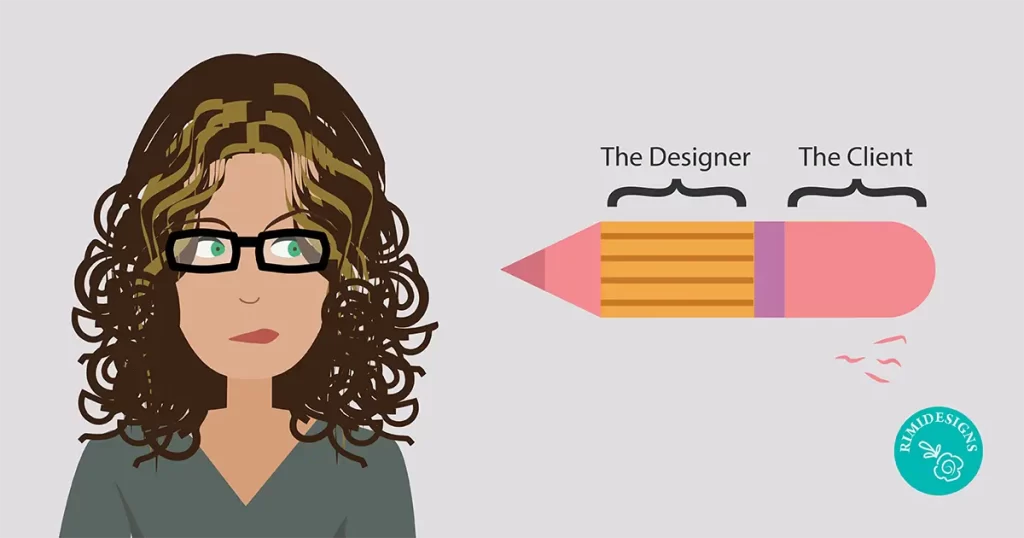
How to Stop Clients Asking for Endless Revisions
As a designer, you’ve probably had the experience of working with a client who repeatedly asks for revisions with no end in sight. It’s frustrating, right? You want to keep the client happy without driving yourself crazy or ruining your profit margin. Both are essential to the success of your business. So it’s important to understand how to avoid getting sucked into the vicious cycle of revisions.
Managing projects and client relationships is a delicate matter and a two-way street. Sometimes, we just end up working with an overcontrolling client who’d do everything themselves “if only I knew Photoshop”. But at other times, we haven’t set the right expectations with the client from the beginning or we’ve mismanaged the client relationship.
Every client is unique, but in general, the following strategies will help you create healthy professional relationships with your clients.
1. Start with the intention to develop a healthy relationship with your client
If you start the project just wanting to finish it quickly and get paid ASAP, then you’re setting yourself up for failure.
An unreasonably short time frame will create stress and anxiety that will cause you to be frustrated about each additional client request, no matter how minor.
Also, the client will feel that you’re in a rush and not intending to give your best. If they feel like they are getting short-changed, they’ll likely start asking for more, more, more. Such a professional relationship is doomed to constant friction and will likely end badly.
However, if you start a project with the mindset of developing a healthy relationship with your client and doing your best, you’ll be off to a good start. Aim for a mutually-beneficial professional collaboration, where you respect each other’s time and ideas.
From here, any hiccups along the way will be easier to resolve.
2. Educate your client about the real purpose of a revision
The design process naturally consists of phases. The designer creates a design draft and asks the client for feedback. Revisions are then made with the goal to move closer to the best end result for the client’s project and its audience. In other words, revisions are part of the design process and they cannot (and should not) be avoided. Rather, they should be done purposefully, by keeping in mind the project’s objectives.
In your first meeting with a new client, explain this process as part of your overall work approach. You’ll set up certain expectations – of both your role and their role. That will give them a clear perspective on how the project will unfold and they’ll understand that revisions are part of the process.
Knowing these boundaries, they should respect the process (you might need to remind them a few times along the way) and not take advantage of you by asking for numerous revisions based on their whims.
3. Clearly define and articulate what is a round of revision
Your client hired you because you’re the professional, not them. They may not know exactly what constitutes a “round of revision”. It can be a vague term for someone not familiar with design jargon. Take the time to explain to your client exactly what a round of revision is and include the specifics in your initial estimate and legal contract.
A round of revision can be explained to your clients as such: Once a design draft is presented, they have a specified number of days to provide their feedback. Once all of their comments, ideas and questions are consolidated and a new version is provided, that’s the end of that round of revision.
Professional tip
Don’t jump into doing a revision right after the client has provided their initial comments. Often people have an immediate reaction that changes after thinking about and reviewing the project over time.
Give a client enough space to formulate all of their thoughts into a cohesive response, then review and confirm the changes they’re requesting. Then and only then, get back to work on it.
Following these clear steps in a round of revisions will structure and pace the project in a way that’s comfortable for the client and less stressful for you.
4. Clearly define how many rounds of revisions are included in your fee
The number of rounds of revisions – based on your professional knowledge of the complexity of the project – should be clearly articulated, both in your legal contract and in the initial estimate you send to the client. The more transparent and informative you are upfront, the less confused your client will be.
In the end, your diligence at the beginning will prevent misunderstandings and conflicts throughout the remainder of the process.
5. Clearly define when change requests will be considered extra work and how this will be billed
There are major revisions and minor ones but your client might not realise there’s a difference. Give your client clear examples of each, so they understand it upfront.
For instance, you could say: “Moving photos and text around the page means we are doing layout changes and that’s a major revision. However, changing a short text phrase here and there is a minor revision.”
Again, these specifics (including how you bill for major revisions – e.g. hourly rate or flat fee) should be included in both your legal contract and the initial estimate you send to your client.
Of course, you can’t include every possible scenario in these documents and many change requests are somewhere in the middle between major and minor. So it’s your job to keep educating the client along the way and referring back to the initial examples you provided at the beginning.
6. Keep the client informed about each phase of the design process
Most clients aren’t aware of the incremental steps a design process entails. Keeping the client informed about each design phase helps prevent misunderstandings about where you are in the overall process.
For example, after you receive the client’s first consolidated feedback, send them a confirmation email. Use a subject line such as, “First round of revisions out of three” and then reiterate the changes you’re planning to do based on their feedback.
Taking time to do this will help you structure your work and manage the revisions, but most importantly, it will keep the client informed about the progress of the project.
7. Don’t forget to show your goodwill and flexibility
Most clients are nervous about choosing the right designer, one who will be committed to the project and do their best to deliver quality work.
If the client doesn’t really trust you, the project will not run smoothly. It’s your job to establish trust and show the client you are coming into the arrangement in a spirit of goodwill. If you push too hard on that extra chargeable time, the client will feel that your primary concern is earning money rather than addressing their needs. So be careful!
Moreover, it could be in your best interest to do a little bit of extra non-billed work here and there because goodwill goes a long way. It helps to strengthen a relationship with a client and reinforce that trust.
A word of warning
Only do this if you don’t feel resentful about it. Make it your choice, not something your client expects from you. If they begin to take advantage of your generosity, refer back to your initial contract and estimate. They’ll respect you for sticking up for yourself.
8. Accept that design is subjective
Sometimes, you and your client won’t agree about the best design solution. Or your client might reject your ideas simply because it doesn’t appeal to them. It can be useless to argue when it’s a matter of personal taste. You might need to just spend that extra time making more revisions.
Although this might be disappointing to you as a designer, simply accept that design is subjective and you, as a designer, are providing a professional service to the client. Thus, plan for this possibility when initially budgeting out your project.
For example, depending on how clear a project is, put a 10-20 per cent “contingency” on top of the actual project time to accommodate this unknown factor. This way you protect our time and avoid any frustrations.
Ideally, you would avoid such a major design overhaul by being on the same design page as your client from the start. An easy way to do this is by creating a virtual design board – including colours, fonts, styles – for your client to look at and approve, instead of relying merely on verbal descriptions. It’s a go-to method for eliminating aesthetic misunderstandings upfront.
9. Accept your mistakes
Design is subjective. Therefore, sometimes we, as designers, truly misunderstand what the client is expecting. Using words to communicate visual tastes and preferences can be tricky and misleading. If your design doesn’t meet the client’s expectations, simply apologise and ensure them that you’ll get it right. And don’t count that round as part of the agreed number of revisions.
It can be a hard and costly lesson but it happens to the best of us. A project succeeds or fails based on how much care and attention we give to the design briefing process. It’s a crucial step that can save hours and heartache down the line.
So, be sure to ask your client the right questions to obtain all of the information you need. Then, use a visual tool to visualise and communicate what the client wants and expects. If you catch discrepancies up front and adjust them, the rest of your project will flow smoothly.
10. Put a stop when needed
Sometimes enough is enough! If a client isn’t complying with what they agreed to in your estimate and contract, you’ll need to start protecting your boundaries or else risk getting taken for a ride.
As long as you have clearly communicated to the client upfront how you manage the revisions, you have a basis for calling a stop to their endless revisions. Confidently and pleasantly say to your client something like this: “Since your request comes after we’ve completed the agreed upon rounds of revisions, I will have to charge you for this.” Short and simple.
11. Don’t waste your time with the wrong clients
That being said, sometimes no matter what you do, a client relationship just doesn’t work. Either the client has a different vision than you can provide or they’re over-controlling, micro-managing or disrespectful. If they’re behaviour is spoiling the synergy, you won’t be able to do your best work.
If you stay in a disagreeable or unfair client situation just because you need the money, you’ll likely end up miserable. This can be soul-crushing to any creative person and it’s not worth compromising your integrity. It’s better to use your time and ingenuity to look for someone who respects your talent and unique creative contribution.
End an unpleasant client relationship sooner rather than later, for everyone’s sake. It might be scary and uncomfortable when you approach them, but it’s liberating once you do it. Just be professional and try to keep your emotions or hurt feelings out of it. Use phrases like “creative differences” and “diverging aesthetic choices”, Avoid “bad taste” and “can’t make up your mind”. If you retain your integrity, you will exit feeling like a professional and you might teach your client a valuable lesson as well.
Conclusions
Managing client relationships is a delicate matter with many nuances. Remember the keys: set expectations upfront, keep the client informed about each phase of the project, put a stop to revisions by referencing your initial agreement, stay flexible and show your good will.
Your ultimate goal should be to do your best within your capabilities, ensure the client is happy and create a piece of work you’ll be proud to include in your portfolio.
The rounds of revisions should be only part of the framework that helps you to do your job well, rather than the sole focus of your work. The right clients will understand this and will appreciate the way you handle your professional relationships.
SOURCE: Creative Bloq
Ready to bring your vision to life? Don’t settle for ordinary, let’s design the extraordinary together! Unleash the power of your ideas with stunning visuals. Your masterpiece is just a click away. Think we’d be a great fit? Work with me and let my expert graphic design skills transform your concepts into captivating designs. Let’s talk!



